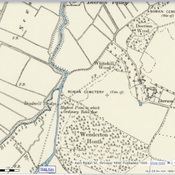Parish church situated outside the city walls of Canterbury and according to Bede was built in the Roman period. The church is of several periods of construction the earliest of which comprises the western half of the present chancel with an extension beneath the present nave. This was built of Roman bricks some of which are clearly re-used. It may be that that this building was a simple church or an earlier building of unknown function later reused as a church. (It has been suggested that originally the site may have been that of a royal residence of Aethelbert and Martha). A later phase of construction effectively enlarged the original building, the early narrow nave being replaced by the present structure. The walls are of blocks of stone with bricks only used occasionally in courses between the stone. Dating for both these phases based on stylistic grounds and methods of construction is problematic. The original building of the first phase may have been constructed in the 7th century or earlier. The chancel was altered in the 14th century1.
Lage:
- Vereinigtes Königreich, Canterbury
- geo:51.277454,1.093476
- Lage ± 0-5 m.
Klassification:
- Villa rustica
- Sichtbar
Identifiers:
- vici:place=14412
Anmerkungen
Parish church situated outside the city walls of Canterbury and according to Bede was built in the Roman period. The church is of several periods of construction the earliest of which comprises the western half of the present chancel with an extension beneath the present nave. This was built of Roman bricks some of which are clearly re-used. It may be that that this building was a simple church or an earlier building of unknown function later reused as a church. (It has been suggested that originally the site may have been that of a royal residence of Aethelbert and Martha). A later phase of construction effectively enlarged the original building, the early narrow nave being replaced by the present structure. The walls are of blocks of stone with bricks only used occasionally in courses between the stone. Dating for both these phases based on stylistic grounds and methods of construction is problematic. The original building of the first phase may have been constructed in the 7th century or earlier. The chancel was altered in the 14th century1.
Referenzen
Verschillende muurdelen van deze kerk stammen uit de 2e eeuw. Voor het uit de 6e eeuw stammend kerkje stond hier een villa1.
Referenzen
In der Nähe
Canterbury Treasure
Late roman silver hoard found 1962 and buried in the early 5th century AD.
Canterbury Roman Museum
Museum
Durovernum Baths
Bath foundations





